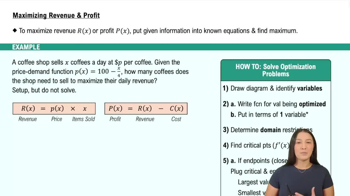Table of contents
- 0. Functions7h 52m
- Introduction to Functions16m
- Piecewise Functions10m
- Properties of Functions9m
- Common Functions1h 8m
- Transformations5m
- Combining Functions27m
- Exponent rules32m
- Exponential Functions28m
- Logarithmic Functions24m
- Properties of Logarithms34m
- Exponential & Logarithmic Equations35m
- Introduction to Trigonometric Functions38m
- Graphs of Trigonometric Functions44m
- Trigonometric Identities47m
- Inverse Trigonometric Functions48m
- 1. Limits and Continuity2h 2m
- 2. Intro to Derivatives1h 33m
- 3. Techniques of Differentiation3h 18m
- 4. Applications of Derivatives2h 38m
- 5. Graphical Applications of Derivatives6h 2m
- 6. Derivatives of Inverse, Exponential, & Logarithmic Functions2h 37m
- 7. Antiderivatives & Indefinite Integrals1h 26m
- 8. Definite Integrals4h 44m
- 9. Graphical Applications of Integrals2h 27m
- 10. Physics Applications of Integrals 2h 22m
5. Graphical Applications of Derivatives
Applied Optimization
Problem 4.1.75a
Textbook Question
Maximizing profit Suppose a tour guide has a bus that holds a maximum of 100 people. Assume his profit (in dollars) for taking people on a city tour is P(n) = n(50 - 0.5n) - 100. (Although P is defined only for positive integers, treat it as a continuous function.)
a. How many people should the guide take on a tour to maximize the profit?
 Verified step by step guidance
Verified step by step guidance1
First, identify the function that represents the profit, which is given as \( P(n) = n(50 - 0.5n) - 100 \). This is a quadratic function in terms of \( n \).
To find the number of people that maximizes the profit, we need to find the critical points of the function. Start by taking the derivative of \( P(n) \) with respect to \( n \).
The derivative \( P'(n) \) can be found using the power rule and the constant rule. Calculate \( P'(n) = \frac{d}{dn}[n(50 - 0.5n) - 100] \).
Set the derivative \( P'(n) \) equal to zero to find the critical points: \( P'(n) = 0 \). Solve this equation for \( n \) to find the value that maximizes the profit.
After finding the critical point, verify that it is a maximum by using the second derivative test or by analyzing the sign changes of \( P'(n) \) around the critical point. Ensure that \( n \) is within the feasible range (0 to 100) for the problem.
 Verified video answer for a similar problem:
Verified video answer for a similar problem:This video solution was recommended by our tutors as helpful for the problem above
Video duration:
2mPlay a video:
Was this helpful?
Key Concepts
Here are the essential concepts you must grasp in order to answer the question correctly.
Profit Function
The profit function P(n) = n(50 - 0.5n) - 100 represents the relationship between the number of people n on a tour and the profit generated. It is a quadratic function, where the profit depends on the number of attendees, accounting for both revenue and costs. Understanding this function is crucial for determining how changes in n affect profit.
Recommended video:

Example 3: Maximizing Profit
Maximization of Functions
Maximizing a function involves finding the input value that yields the highest output. In this context, we need to find the value of n that maximizes the profit function P(n). This typically involves taking the derivative of the function, setting it to zero, and solving for n to find critical points, which can indicate maximum profit.
Recommended video:

Maximizing Profit & Revenue
Critical Points and Second Derivative Test
Critical points occur where the first derivative of a function is zero or undefined, indicating potential maxima or minima. To confirm whether a critical point is a maximum, the second derivative test can be applied. If the second derivative is negative at a critical point, it indicates a local maximum, which is essential for determining the optimal number of tour participants.
Recommended video:

The Second Derivative Test: Finding Local Extrema

 1:13m
1:13mWatch next
Master Intro to Applied Optimization: Maximizing Area with a bite sized video explanation from Callie
Start learningRelated Videos
Related Practice







